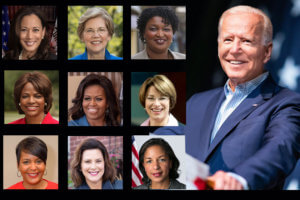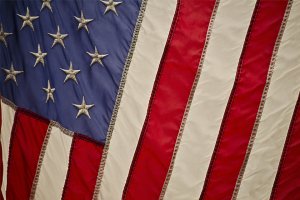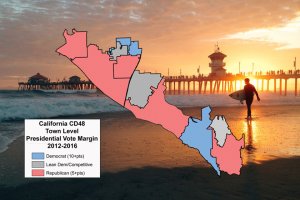West Long Branch, NJ – Bernie Sanders leads the field in California’s Super Tuesday primary, despite the fact that only 1 in 4 likely voters currently support him. The Monmouth (“Mon-muth”) University Poll finds that Sanders’ vote share could increase, though, if it came down to a two-person race. Latino voters are a core constituency for Sanders in the Golden State. With early ballots already rolling in, few voters say there is a high possibility they will change their candidate choice.
Among California voters who are likely to participate in the March 3 Democratic primary, support currently stands at 24% for Sanders, followed by 17% for Joe Biden, 13% for Mike Bloomberg, 10% for Elizabeth Warren, and 9% for Pete Buttigieg. Support for other candidates includes Tom Steyer at 5%, Amy Klobuchar at 4%, and Tulsi Gabbard at 2%. Another 13% of likely primary voters remain undecided and do not lean toward any candidate at this time.
“California is the big prize on Super Tuesday. As the poll currently stands, it’s possible that only two or three candidates reach viability in any given congressional district. That would enable Sanders to rack up half the delegates or more while only earning one-quarter of the total vote,” said Patrick Murray, director of the independent Monmouth University Polling Institute.
More than 1 in 3 voters under 50 years old prefer Sanders (36%), followed by Warren (15%), while those aged 65 and over give an edge to Biden (29%) over Bloomberg (14%) and Sanders (12%). Hispanic voters favor Sanders (38%) over Biden (17%). Non-Hispanic white voters are divided between Sanders (18%) and Warren (18%), followed by Bloomberg (14%), Biden (13%), and Buttigieg (11%). Voters of other racial backgrounds, including black and Asian voters, prefer Biden (32%) over Sanders (17%) and Bloomberg (17%).
“There is a high level of interest in voting in this primary, suggesting there could be record turnout. If this pans out, it is likely to include a relatively high share of Latino voters, a group that is particularly friendly to Sanders,” said Murray. The survey findings are based on a likely voter screen that results in an electorate that is 49% non-Hispanic white, 31% Hispanic, 11% black, and 7% Asian.
More than 6 in 10 California primary voters will cast their ballots early. Among those who have already voted or intend to vote prior to Super Tuesday, the race is close – with 20% backing Sanders, 19% Biden, 14% Bloomberg, 11% Warren, and 11% Buttigieg. Sanders has a clear lead among the one-third of likely voters who intend to go to their polling places on March 3. He gets 28% of the primary day vote, compared to 14% for Biden, 13% for Bloomberg, and 10% for Warren.
About 4 in 10 likely California Democratic primary voters are set on their candidate choice, including 10% who have already mailed in their ballot and 31% who say they have not voted yet but are firmly decided. Just under half of likely voters are open to supporting a different candidate than their current choice, but only 10% say there is a high possibility this will happen. Another 26% say there is a moderate possibility of changing their mind and 9% say there is a low possibility. The results out of Iowa and New Hampshire had little impact on how California voters are viewing this race. More than 3 in 4 say the outcomes of those contests did not really change their thinking about the upcoming primary (68%) or they have already voted (10%). Among the small number who say they took a second look at the field because of the first two states, just under half changed their mind about whom to support (8%) and just over half did not (10%).
The poll asked voters how they would vote in hypothetical two-person races pitting Sanders against the more moderate candidates. Support for Sanders grows in each of these matchups, beating out Biden (44% to 36%), Bloomberg (48% to 31%), Buttigieg (51% to 26%), and Klobuchar (54% to 24%). In these head-to-head scenarios, Sanders’ support among voters under 50 years old grows to about two-thirds in that group. He also gets an outright majority of the Hispanic vote in all four hypothetical contests.
“Sanders may get a decent delegate haul in the currently crowded field. But if it comes down to a two-person contest in California, Sanders could rack up two-thirds of available delegates and be well on his way to the nomination,” said Murray.
Like Democrats elsewhere, California primary voters are looking for electability – 63% say beating Trump is more important to their vote than lining up with a candidate on any policy issue. Another 21% say electability is as important as their top policy concern, while just 13% say it is less important than issue alignment. Among those who say beating Trump is their top priority, 21% support Sanders, 21% support Biden, 17% support Bloomberg, and 11% support Warren. Among those who say it is not a top priority, 31% support Sanders and 11% back Buttigieg.
Looking at candidate qualities, 61% of likely Democratic primary voters say they want someone who can unite the country, while 32% say they prefer someone who can bring about change. One-third of “change” voters back Sanders (32%), followed by Biden (17%), Bloomberg (12%), and Warren (12%). Sanders (19%) ties with Biden (19%) among “unite” voters, ahead of Bloomberg (15%), and Buttigieg (12%).
California Democratic primary voters tend to be hopeful about their eventual nominee’s chances in November. Most (55%) believe that Trump will lose to the Democrat while 35% think it is more likely that Trump will win reelection. More than 6 in 10 likely primary voters feel optimistic about this year’s election (31% very and 31% somewhat), while 3 in 10 are pessimistic (12% very and 19% somewhat). Hispanic voters (80%) are more likely than non-Hispanic white voters (49%) to feel optimistic about the 2020 election. Optimism among those of other racial backgrounds, including black and Asian voters, (62%) falls in between these two groups.
The Monmouth University Poll was conducted by telephone from February 16 to 19, 2020 with 408 California voters who are likely to vote in the Democratic presidential primary on March 3, 2020, out of 570 registered voters that were contacted for the poll. The question results in this release have a margin of error of +/- 4.9 percentage points. The poll was conducted by the Monmouth University Polling Institute in West Long Branch, NJ.
QUESTIONS AND RESULTS
(* Some columns may not add to 100% due to rounding.)
1. If the Democratic primary election for president was today, would you vote for [NAMES WERE ROTATED]? [If UNDECIDED: If you had to vote for one of these candidates at this moment, who do you lean toward?]
| (with leaners) | Feb. 2020 |
| Bernie Sanders | 24% |
| Joe Biden | 17% |
| Mike Bloomberg | 13% |
| Elizabeth Warren | 10% |
| Pete Buttigieg | 9% |
| Tom Steyer | 5% |
| Amy Klobuchar | 4% |
| Tulsi Gabbard | 2% |
| (VOL) Other | 1% |
| (VOL) Undecided | 13% |
| (n) | (408) |
2. Are you firmly decided on your candidate choice or are you open to the possibility of voting for a different candidate on primary day? [If OPEN: Would you rate the possibility of supporting a different candidate as high, moderate, or low?]
| Feb. 2020 | ||
| Firmly decided | 31% | |
| Open to different candidate … | high possibility | 10% |
| moderate possibility | 26% | |
| low possibility | 9% | |
| Already voted | 10% | |
| (VOL) Don’t know | 1% | |
| No first choice (from Q1) | 13% | |
| (n) | (408) | |
3. Who would be your second choice if you had to make one?
| Feb. 2020 | |
| Bernie Sanders | 16% |
| Joe Biden | 10% |
| Elizabeth Warren | 12% |
| Mike Bloomberg | 8% |
| Pete Buttigieg | 7% |
| Amy Klobuchar | 7% |
| Tom Steyer | 3% |
| Tulsi Gabbard | 1% |
| Already voted | 10% |
| (VOL) No one | 3% |
| (VOL) Undecided | 23% |
| (n) | (408) |
4. Did the results of the New Hampshire primary and Iowa caucuses make you take a second look at any of the candidates, or did this not really change your thinking about who you will support in the primary? [If TOOK A SECOND LOOK: Did you actually change your mind about who to support or not?]
| Feb. 2020 | ||
| Took a second look, and… | changed mind | 8% |
| did not change mind | 10% | |
| Not really change thinking | 68% | |
| Already voted | 10% | |
| (VOL) Don’t know | 5% | |
| (n) | (408) | |
5. I am going to read you a few pairs of candidate names. If the Democratic nomination came down to just these two candidates by the California primary, who would you vote for? [CANDIDATE PAIRS WERE ROTATED AND NAMES WERE ROTATED]
Bernie Sanders and Joe Biden
| Feb. 2020 | |
| Bernie Sanders | 44% |
| Joe Biden | 36% |
| Already voted | 10% |
| (VOL) Neither | 5% |
| (VOL) Don’t know | 5% |
| (n) | (408) |
Bernie Sanders and Pete Buttigieg
| Feb. 2020 | |
| Bernie Sanders | 51% |
| Pete Buttigieg | 26% |
| Already voted | 10% |
| (VOL) Neither | 6% |
| (VOL) Don’t know | 7% |
| (n) | (408) |
Bernie Sanders and Amy Klobuchar
| Feb. 2020 | |
| Bernie Sanders | 54% |
| Amy Klobuchar | 24% |
| Already voted | 10% |
| (VOL) Neither | 6% |
| (VOL) Don’t know | 6% |
| (n) | (408) |
Bernie Sanders and Mike Bloomberg
| Feb. 2020 | |
| Bernie Sanders | 48% |
| Mike Bloomberg | 31% |
| Already voted | 10% |
| (VOL) Neither | 4% |
| (VOL) Don’t know | 6% |
| (n) | (408) |
6. When thinking about who you are supporting in the Democratic primary, how much of a factor is beating Donald Trump next November – is it more important than any policy issue you are concerned with, about as important as your top policy concern, or less important than your top policy concern?
| Feb. 2020 | |
| More important | 63% |
| About as important | 21% |
| Less important | 13% |
| (VOL) Don’t know | 3% |
| (n) | (408) |
7. If you had to choose, are you more concerned about choosing a candidate who can bring about change or a candidate who can unite the country?
| Feb. 2020 | |
| Bring about change | 32% |
| Unite the country | 61% |
| (VOL) Neither | 3% |
| (VOL) Don’t know | 4% |
| (n) | (408) |
8. Do you feel optimistic or pessimistic about the 2020 presidential election? [Is that very or somewhat optimistic/pessimistic?]
| Feb. 2020 | |
| Very optimistic | 31% |
| Somewhat optimistic | 31% |
| Somewhat pessimistic | 19% |
| Very pessimistic | 12% |
| (VOL) Neither, don’t care | 2% |
| (VOL) Don’t know | 5% |
| (n) | (408) |
9. As of right now, what do you think the chances are that Donald Trump gets reelected in November – do you think he will definitely get reelected, probably get reelected, probably lose to the Democrat, or definitely lose to the Democrat?
| Feb. 2020 | |
| Definitely get reelected | 7% |
| Probably get reelected | 28% |
| Probably lose to the Democrat | 37% |
| Definitely lose to the Democrat | 18% |
| (VOL) Depends on the Democrat | 3% |
| (VOL) Don’t know | 7% |
| (n) | (408) |
METHODOLOGY
The Monmouth University Poll was sponsored and conducted by the Monmouth University Polling Institute from February 16 to 19, 2020 with a statewide random sample of 570 California voters drawn from a list of voters registered as Democrats or with no party affiliation who participated in a primary or general election in the 2016 or 2018 election cycles, or have registered to vote since November 2018. This includes 144 contacted by a live interviewer on a landline telephone and 426 contacted by a live interviewer on a cell phone, in English and Spanish. Results are based on 408 voters who are likely to vote in the Democratic presidential primary on March 3, 2020. Monmouth is responsible for all aspects of the survey design, data weighting and analysis. The full sample is weighted for party registration, age, gender, race, education and region based on state voter registration list information and U.S. Census information (CPS 2018 supplement). Data collection support provided by Braun Research (field) and Aristotle (voter sample). For results based on the sample of likely Democratic primary voters, one can say with 95% confidence that the error attributable to sampling has a maximum margin of plus or minus 4.9 percentage points (unadjusted for sample design). Sampling error can be larger for sub-groups (see table below). In addition to sampling error, one should bear in mind that question wording and practical difficulties in conducting surveys can introduce error or bias into the findings of opinion polls.
| DEMOGRAPHICS (weighted) |
| Party Registration |
| 77% Democrat |
| 23% None |
| Self-Reported Party |
| 73% Democrat |
| 24% Independent |
| 3% Republican |
| 44% Male |
| 56% Female |
| 18% 18-34 |
| 20% 35-49 |
| 35% 50-64 |
| 27% 65+ |
| 49% White, non-Hispanic |
| 11% Black |
| 31% Hispanic |
| 7% Asian |
| 1% Other |
| 52% No degree |
| 48% 4 year degree |
| Region |
| 25% LA area |
| 24% South |
| 13% Central |
| 38% North |
Click on pdf file link below for full methodology and crosstabs by key demographic groups.




